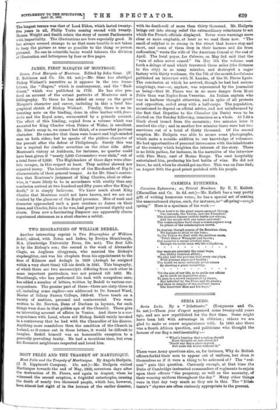MONT PELEE AND Tlih TRAGEDY OF MARTINIQUE.
Mont Pelee and the Tragedy of Martinique. By Angelo Heilprin. (J. B. Lippincott Company. 15s. net.)—Mr. Heilprin visited Martinique towards the end of May, 1902, seventeen days after the destruction of St. Pierre, and again in August, when he witnessed the second eruption, a frightful catastrophe, causing the death of nearly two thousand people, which has, however, been alinost lost sight of in the horrors of the earlier disaster, with its death-roll of more than thirty thousand. Mr. Heilprin brings out into strong relief the extraordinary reluctance to act which the French officials displayed. Never were warnings more clear or more emphatic, at least as we read them now. "The smell of sulphur is so strong in the street that horses stop and snort, and some of them drop in their harness and die from suffocation," wrote the wife of the American Consul at the end of April. The local paper, Les Colonies, on May 3rd said that the "rain of ashes never ceased." On May 5th the volcano sent forth a deluge of mud which traversed three miles (the distance to the city) in as many minutes, and destroyed a sugar factory with thirty workmen. On the 7th of the month Les Colonies published an interview with M. Landes, of the St. Pierre Lycie. The conclusion at which he arrived, though he had had serious misgivings, was—or, anyhow, was represented by the journalist as being—that St. Pierre was in no more danger from Mont Pelee than was Naples from Vesuvius. An Italian captain who was in harbour thought otherwise, and in spite of all protests and opposition, sailed away with a half-cargo. The population, accustomed to depend on official advice, and not uninfluenced by the fact that Deputies to the Chamber (in Paris) were to be elected on the Sunday following, remainea as a whole. At 7.50 a black cloud issued from the mountain; two minutes later it reached the city ; and in another few minutes there were but two survivors out of a total of thirty thousand. Of the second eruption Mr. Heilprin was able to secure some photographs, which make a notable addition to our knowledge of volcanoes. He had opportunities of personal intercourse with the inhabitants of the country which heighten the interest of the story. There is no little pathos, for instance, in the narrative of the interview with Pere Mary, curb of Morrie Rouge. The curb hospitably entertained him, producing his last bottle of wine. He did not know, he said, when he should get another. This was on June 2nd ; on August 30th the good priest perished with his people.


























































 Previous page
Previous page